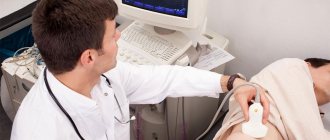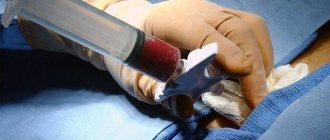Why colonoscopy, and is it possible for hemorrhoids?
If the doctor does not have enough data to make a diagnosis or he needs to investigate the problem in as much detail as possible, he will prescribe the patient a procedure such as a colonoscopy. The device used for the examination is equipped with special precision optics, due to which the examination error is small. A coloproctologist sees the condition of the mucous membrane down to the smallest scratches and even microcracks: with the help of colonoscopy, hemorrhoids can actually be noticed in their infancy.
This examination method cannot be called pleasant, but it is not accompanied by painful sensations. The examination does not require anesthesia, although many private clinics offer clients this option. Regarding its necessity, it is worth discussing separately (more on this below).
Another advantage of colonoscopy is that it is not only a diagnostic, but also a therapeutic method. The doctor may carry out some corrective measures if the pathology allows for therapeutic intervention.
If during the procedure the doctor sees a picture that makes him think about a possible malignant tissue lesion, he can take a piece of tissue directly during the colonoscopy for further biopsy.
Colonoscopy allows you to diagnose colitis, Crohn's disease, benign and malignant formations. This technique is also informative for hemorrhoidal disease.
Contraindications for carrying out
Colonoscopy under anesthesia is the most common form of examination of gastrointestinal diseases, but there are a number of diseases for which this diagnosis is not performed. Such diseases include:
- bronchial asthma;
- Chronical bronchitis;
- mitral valve stenosis (located between the left ventricle and the atrium);
- psychosomatic disorders;
- heart failure;
- inflammation of the peritoneum;
- peritonitis;
- stroke;
- ischemic, ulcerative colitis in the late stage;
- hemophilia, other diseases associated with blood clotting;
- pregnancy;
- postoperative period.
Features of the procedure in childhood
Diagnosis of the intestines in young patients is carried out under the strict supervision of a doctor. Children under 12 years of age are always recommended for colonoscopy under anesthesia (general or superficial), therefore, before the examination, it is necessary to check the child’s reaction to anesthesia, do a blood test, and conduct a general examination of the patient. Before the procedure, children, just like adults, need to follow a diet and cleanse the intestines. After the examination, the child must remain in the hospital for several days.
Contraindications to colonoscopy under anesthesia in children are the following diseases:
- progressive rickets;
- exhaustion, malnutrition;
- infections of the upper respiratory tract, internal organs;
- lung diseases;
- lyoderma.
How to prepare for the examination
If your intestines are properly prepared for the procedure, it will be easier and less uncomfortable for you. Finally, this will simplify the work of the specialist - the work time will be reduced and its quality will increase.
Rules for preparing for the examination:
- Three days before the test, remove fruits, vegetables, all flour and grains from the menu. If you are wondering what to eat under such conditions, options still remain - fish, meat, eggs, dairy products.
- On the eve of the procedure, take a special medication to cleanse the intestines: Fortrans, Lavacol, etc. These remedies are drunk in the afternoon, after 16.00, in small portions. In total, you will drink about 4 liters of this product. During this preparation, do not eat anything - just drink water, green tea, and clear juices.
- On the day of the procedure, do not eat anything. You can drink half a glass of water if your doctor has not given you other instructions. You can take with you a small package of kefir or yogurt, juice, an energy bar - in a word, something that will please you after the procedure.
Colonoscopy for hemorrhoids and other diseases can be performed under anesthesia. But this option cannot be considered ideal. The disadvantages of the procedure, which is carried out “in a dream,” are significant. Any anesthesia, as you know, carries health risks. And not the most complex research is by no means a reason for such risks. Finally, such a procedure will be without contact between the specialist and the patient: the patient will not give the doctor the opportunity to navigate the situation, as well as some anatomical features of the location of the intestine.
Preparing for a colonoscopy
In order to conduct high-quality research, you need to properly prepare for it. Preparation consists of thoroughly cleansing the intestines of food debris and feces. Preparation takes place in several stages:
- A few days before the procedure, the patient should switch to an easily digestible diet. Foods that promote gas formation in the intestines (apples, cabbage, black bread, grapes) should be excluded from the diet.
- The second stage of preparation can be divided into two ways: cleansing the intestines using the drug Fortrans or using cleansing enemas. If cleansing is carried out using the drug, then you need to prepare a solution at the rate of 1 sachet per 20 kg of patient weight. Usually 3-4 sachets are enough. Each sachet is diluted with one liter of water. You need to gradually drink the diluted drug. It must be remembered that the last dose of medication should be taken 4 hours before the procedure. Taking Fortrans is not recommended for children under 12 years of age and is contraindicated in case of intestinal obstruction.
If bowel cleansing is carried out using enemas, then they begin to be done in the evening 3 times every 2 hours. The intestines are considered clean if only clean water comes out after the enema. In the morning, the enema should be done one last time before the procedure.
What homemade laxatives will help cleanse the intestines?
If the intestines are not cleansed sufficiently, the procedure will not work.
Before the procedure, the doctor explains to the patient how the procedure will take place. Particularly sensitive people can be given anesthesia.
It’s embarrassing, painful and scary: what does the proctologist say?
Is it possible to do a colonoscopy for hemorrhoids? Yes, if such a decision was voiced by the doctor. He also gives the patient recommendations - how to prepare for medical manipulation, what to eat and what to refuse. The doctor describes all the manipulations that await the patient and sets him up accordingly.
Myth or not - is it true that colonoscopy is:
- Scary. It is scary exactly to the extent that this feeling gives rise to everything unknown. A personal approach is important here - for one patient it is better not to describe the details of the colonoscopy, his imagination is very active. The other, on the contrary, wants to know everything in detail: he will play out this procedure in his head, and this will help him tune in to the real study.
- Hurt. During the procedure, the intestine is internally inflated with air - this causes discomfort and a feeling of bloating. But it decreases immediately after the procedure and goes away within a day.
- Ashamed. For a coloproctologist this is a job, for you it is a procedure that is extremely necessary for your health. Everything else is excessive reflection, inappropriate in this situation. The doctors themselves say that they work with the patient, and it doesn’t matter to them what gender or age they are. And they are ready for any incidents during the study (if you are so afraid of it).
Colonoscopy of the intestine for hemorrhoids is simply an instrumental examination that doctors perform very often, and fears are unnecessary here. The most important thing is that the manipulations will give results, and your treatment will reach a new stage.
What is a virtual colonoscopy
Virtual intestinal colonoscopy for hemorrhoids is a modern examination method, a type of computed tomography. The tomograph device allows you to recreate a picture of the patient’s intestines.
Virtual colonoscopy allows you to identify most disorders in the intestines and is absolutely painless. It is relevant when it is necessary to assess the condition of hemorrhoids and obtain information about areas of inflammation. The study is completely painless and has a lot of advantages. But due to the presence of x-ray radiation, it is not recommended during pregnancy.
Virtual colonoscopy allows you to assess the dynamics of the intestine and its position without damaging the mucous membrane and causing inconvenience for the patient. The photographs clearly show the thickness, relief of the intestines, the condition of the mucous membrane of the large and rectal intestines, as well as detailed information about all the processes occurring there.
This procedure, just like a regular colonoscopy, requires preliminary preparation.
Description of the procedure
The patient enters the office and undresses to the waist. He is offered a special robe, as well as proctological panties. In most clinics today, the patient is given such disposable special underwear with a hole in the right place, which will save you from unnecessary embarrassment.
If necessary, the doctor will administer local anesthesia using a special gel.
How is a colonoscopy performed?
- The patient is placed on the couch on the left side. He needs to put his knees to his chest.
- Air is pumped into the patient's rectum - this is done so that during the test, when moving the device, there are no negative sensations or injuries to the mucous membrane.
- The doctor inserts the probe of the device into the rectal canal to a certain point (to the Burginian valve).
- As the instrument moves, air is pumped into the intestine: it straightens out, and the doctor can carefully examine the condition of the area being examined. All data is sent to the monitor.
- Upon completion of the study, the probe is removed from the anus.
Hemorrhoids after colonoscopy do not enter the exacerbation phase if the doctor does everything correctly. In addition, if, for example, the patient has rectal bleeding, the procedure will not be performed. But it happens that the blood is stopped with the help of a colonoscope - the device can cauterize the affected area.
In short, the research procedure is performed according to indications, and is not done when there are undesirable factors (for example, purulent processes).
Will it hurt?
No one will perform a colonoscopy for acute inflammation of hemorrhoids. Firstly, no doctor wants the patient to suffer, and secondly, bleeding nodes and swollen tissues make it difficult to carry out the procedure itself.
The colonoscope is inserted into the anus. Normally, this does not cause any pain, since the diameter of the probe is 10-12 mm, and the anal opening can expand up to 3-5 cm. The presence of hemorrhoids narrows the opening, but there is still a gap sufficient for inserting the probe.
Usually, an exacerbation of hemorrhoids is first treated, and only then a colonoscopy is performed. If the person is very sensitive or the hole is narrow, anesthetic gels are used to lubricate the anal ring. The patient and doctor decide this together.
Unpleasant sensations may occur when inflated with air. This is a feeling of fullness, heaviness, pain. Normally, the intestines do not swell like this, and the body reacts to the unusual impact. During the procedure, the patient is conscious, and everything needs to be told to the doctor. The nurse can help change the position of the body, the depth and frequency of breathing, and the doctor can help remove excess air.
The day before, the intestines are cleansed for 2-3 days: you need to avoid rough food, do enemas and take drugs like Fortrans, Levacol and the like. Each medical institution has its own training characteristics. On the eve of the colonoscopy, the patient is given a reminder according to which he must prepare. The point of preparation is to completely remove feces from the intestines so that the examination is effective. If the intestines are poorly cleaned and the doctor cannot examine all the folds, the procedure will have to be repeated.
In special cases, when there is severe inflammation of the hemorrhoids or bleeding, the procedure is performed under intravenous anesthesia.
Intravenous anesthesia is a non-inhalation anesthesia when the anesthetic is injected directly into the vascular bed. The use of breathing equipment is not required.
A colonoscope allows you to stop bleeding, simultaneously inject medicinal solutions directly to the site of inflammation, or cut off a polyp with a special loop. 25-30 minutes are enough to carry out all manipulations “with the head”; general anesthesia is not needed for this. Whether a colonoscopy can be done in a particular case is determined by the attending physician.
What to do after the procedure
The patient will not receive strict prohibitions. But it’s still stupid to deny that such an examination is stressful for the body. There may be some pain in the lower abdomen for a short time. Therefore, the patient should simply come home and lie down.
And if you are tormented by the remaining air in the intestines, you should drink activated/white charcoal. There are no dietary restrictions. Before the procedure, the doctor treats the anal area with an antiseptic; the administration itself is painless, so exacerbation of hemorrhoids after diagnosis is excluded.
The risk of complications is low. Of course, a lot depends on the professionalism of the doctor - the most serious complication will be damage to the intestinal wall. This happens if there are ulcerative areas and purulent processes in the intestinal mucosa. Diarrhea after colonoscopy is explained by the use of strong laxatives and enemas, as well as stress.
The likelihood of complications after colonoscopy
Complications after intestinal colonoscopy for hemorrhoids are extremely rare, but the doctor is obliged to warn about the consequences after this procedure:
- bloating that does not go away for a long time;
- the appearance of abdominal pain;
- temperature increase;
- the appearance of traces of blood after defecation;
- the appearance of uncomfortable sensations and pain during bowel movements;
- the appearance of diarrhea.
To facilitate bowel movements and prevent unpleasant consequences, you can immediately after a colonoscopy drink plantain tincture (1 tablespoon of herb per 1 glass of boiled water) or activated charcoal diluted in water. It is necessary to use painkillers only after consultation with your doctor.
Colonoscopy is a mandatory diagnostic method for suspected hemorrhoids. Allows the doctor to choose the most effective methods of treating the disease. This examination will help to timely identify the presence of malignant neoplasms and take the necessary therapeutic measures for their treatment. In which cases colonoscopy can be used, and which are included in the list of contraindications for this procedure, only the attending doctor can decide.
Useful video
What is a colonoscopy and how is it performed, learn from the video:
Today, one of the most accurate methods for diagnosing pathological processes in the colon is colonoscopy. This type of examination is much more informative than rectomanoscopy, since it allows you to visually assess the condition of the epithelial layer and peristalsis of most of the intestine - the straight, sigmoid and blind sections.
Carrying out this procedure helps practitioners detect possible anomalies of intestinal development, tumor formations, fistulas, cicatricial narrowings, diverticula and make a competent diagnosis. As an additional study, colonoscopy is prescribed for hemorrhoids - to clarify the preliminary diagnosis and for the purpose of clinical differentiation of rectal pathologies.
Many patients suffer from discomfort and pain due to varicose veins protruding from the anus. Having received a referral for diagnostics, they are worried: will the fiber colonoscope tube damage the inflamed tissue? In our article, we want to tell you why it is necessary to conduct an endoscopic examination of the final part of the digestive tract, when diagnosis is contraindicated, how to prepare for it, and whether it is possible to do a colonoscopy for hemorrhoids.
Rules of conduct at the end of the study
In order to avoid puncture of the intestinal walls, when studying their condition with a fibercolonoscope, the patient must follow all the doctor’s instructions. If the procedure is performed on an outpatient basis, after its completion the patient remains under the supervision of medical specialists for two hours.
After this, you can return to your normal rhythm of life. If you feel discomfort after pumping air, you can take white coal and lie on your stomach. Diagnosis is carried out by an experienced, qualified specialist and complications during and after the procedure are extremely rare.
However, rupture of the hemorrhoidal cone, bleeding, and penetration of the infectious pathogen into the intestinal tissue may occur. Colonoscopy is considered a mandatory additional method of examining the intestines for hemorrhoids. However, the decision to carry out a diagnostic procedure is made by the proctologist monitoring the patient’s condition.
Hemorrhoids are a disease of the rectum, manifested in the form of enlargement, bleeding and prolapse of internal venous nodes. Colonoscopy is an unpleasant but informative procedure; using the method, neoplasms of various types and other intestinal pathologies are identified. For hemorrhoids, if the clinical picture is not clear enough, diagnostics will be appropriate to confirm the diagnosis and prescribe appropriate treatment.
Diagnostic features
Compared to other methods of examining the intestines, colonoscopy has the following advantages:
- Credibility. Making mistakes is almost impossible - the fiber colonoscope is equipped with lighting and optical devices that allow a high-quality visual examination of the intestinal mucosa and assess its condition.
- Less traumatic. Despite the unpleasant sensations when air is supplied, which straightens the intestine and facilitates the advancement of the instrument, there is no injury to the mucous membrane.
- Multifunctionality. During the procedure, minor manipulations are performed for therapeutic purposes to avoid proctological surgery.
Colonoscopy is recommended for early detection of hemorrhoidal process. An endoscopist can take a biopsy sample - a piece of the intestinal mucosa, which is sent for laboratory testing to confirm or refute the diagnosis.











